When I had my equipment installed, the gas fitter (who does a large amount of pool gas service) suggested that I run my pump at higher RPM when the heater is on, in order to extend the lifespan of the heater. Is there any credence to this? Does flow rate above the minimum required for the heater to operate have an impact, outside of a small change in heater efficiency? I have been turning my pump up any time I run the heater just in case, but if I don't need to be doing this, I might as well leave it at it's normal 24/7 low RPM setting.
Does flow rate through a heater correlate to heater lifespan?
- Thread starter AW139
- Start date
You are using an out of date browser. It may not display this or other websites correctly.
You should upgrade or use an alternative browser.
You should upgrade or use an alternative browser.
- Jul 21, 2013
- 52,856
- Pool Size
- 35000
- Surface
- Plaster
- Chlorine
- Salt Water Generator
- SWG Type
- Pentair Intellichlor IC-60
No, there are no facts to support that.
If there was the manufacturer woudl state so in their manual. Manufacturer state the minimum and maximum flow rates for the heater. I would not run a heater at the minimum flow rate.
Flow rate for your Max-E-Therm 200 is 20 to 120 GPM. I would run it in the 30-50 GPM range.
If there was the manufacturer woudl state so in their manual. Manufacturer state the minimum and maximum flow rates for the heater. I would not run a heater at the minimum flow rate.
Flow rate for your Max-E-Therm 200 is 20 to 120 GPM. I would run it in the 30-50 GPM range.
No, there are no facts to support that.
If there was the manufacturer woudl state so in their manual. Manufacturer state the minimum and maximum flow rates for the heater. I would not run a heater at the minimum flow rate.
Flow rate for your Max-E-Therm 200 is 20 to 120 GPM. I would run it in the 30-50 GPM range.
Makes sense. I'm re-configuring my pad a tiny bit in the spring to add a SWG, and replacing the existing check valve with a check valve/flow meter. So that should keep me in the ballpark. I kinda have no real guess on what my GPM is currently.
If anything, excessive flow will cause mechanical erosion of the copper.
Copper pipe is usually limited to 6 or 8 feet per second.
The heat exchanger has 6 tubes but it is a double pass system, so it is 4 and 2 or 3 and 3.
The tubes look like about 1/2" or 3/4" diameter pipe.
So, you probably do not want more than about 40 gpm max going through the heat exchanger.
The heater has an internal bypass, so not all of the water goes through the heat exchanger anyway.
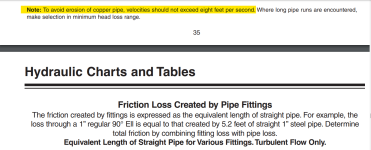
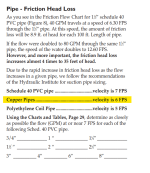
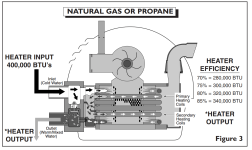

 issuu.com
issuu.com

 issuu.com
issuu.com

 issuu.com
issuu.com


 issuu.com
issuu.com
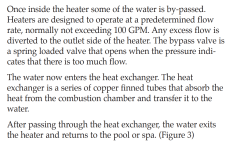
Once inside the heater some of the water is by-passed.
Heaters are designed to operate at a predetermined flow rate, normally not exceeding 100 GPM. Any excess flow is diverted to the outlet side of the heater.
The bypass valve is a spring loaded valve that opens when the pressure indicates that there is too much flow.
The water now enters the heat exchanger.
The heat exchanger is a series of copper finned tubes that absorb the heat from the combustion chamber and transfer it to the water.
After passing through the heat exchanger, the water exits the heater and returns to the pool or spa. (Figure 3)
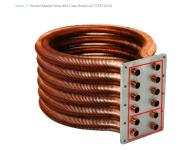
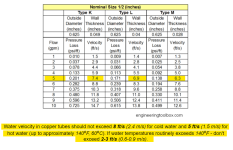
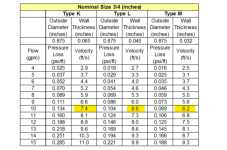
 www.engineeringtoolbox.com
www.engineeringtoolbox.com
Copper pipe is usually limited to 6 or 8 feet per second.
The heat exchanger has 6 tubes but it is a double pass system, so it is 4 and 2 or 3 and 3.
The tubes look like about 1/2" or 3/4" diameter pipe.
So, you probably do not want more than about 40 gpm max going through the heat exchanger.
The heater has an internal bypass, so not all of the water goes through the heat exchanger anyway.



thephta Publisher Publications - Issuu
The Pool & Hot Tub Alliance advances the common interests of the industry by providing education, industry leadership, legislative and regulatory advocacy, standards development, research and market growth to increase our members' professionalism, knowledge and profitability.

ANSI/APSP/ICC-1 2014 (R2023) American National Standard for Public Swimming Pools
This Standard provides recommended minimum guidelines for the design, equipment, operation, and installation of new construction and renovation of public pools for builders, installers, and pool operators. It also is intended to assist government and other regulatory bodies in the development...

2022 CPO Manual
Read 2022 CPO Manual by thePHTA on Issuu and browse thousands of other publications on our platform. Start here!

ANSI/APSP/ICC-11 2019 American National Standard for Water Quality in Public Pools and Spas
The ANSI/APSP/ICC-11 2019 American National Standard for Water Quality in Public Pools and Spas provides recommended minimum guidelines for the specifications for recreational water quality parameters in public pools and spas. An Appendix A includes explanatory sections about the values for the...

Once inside the heater some of the water is by-passed.
Heaters are designed to operate at a predetermined flow rate, normally not exceeding 100 GPM. Any excess flow is diverted to the outlet side of the heater.
The bypass valve is a spring loaded valve that opens when the pressure indicates that there is too much flow.
The water now enters the heat exchanger.
The heat exchanger is a series of copper finned tubes that absorb the heat from the combustion chamber and transfer it to the water.
After passing through the heat exchanger, the water exits the heater and returns to the pool or spa. (Figure 3)



Copper Tubes - Pressure Loss vs. Water Flow
Water flow and pressure loss <i>(psi/ft)</i> due to friction in copper tubes ASTM B88 Types K, L and M.
Attachments
Last edited:
Also, the power usage increases exponentially.
If you double the flow rate, the power usage goes up by 6 to 8 times.
If the power usage at 40 GPM is 400 watts, then the power usage at 80 GPM will be about 2,400 watts to maybe up to 3,200 watts.
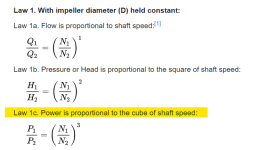
 en.wikipedia.org
en.wikipedia.org
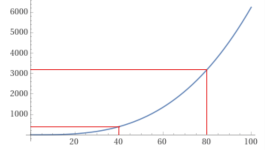
 www.wolframalpha.com
www.wolframalpha.com
If you double the flow rate, the power usage goes up by 6 to 8 times.
If the power usage at 40 GPM is 400 watts, then the power usage at 80 GPM will be about 2,400 watts to maybe up to 3,200 watts.

Affinity laws - Wikipedia

y = 0.00625x^3, x from 0 to 100 - Wolfram|Alpha
Wolfram|Alpha brings expert-level knowledge and capabilities to the broadest possible range of people—spanning all professions and education levels.
What flow did the gas fitter recommend?When I had my equipment installed, the gas fitter (who does a large amount of pool gas service) suggested that I run my pump at higher RPM when the heater is on, in order to extend the lifespan of the heater.
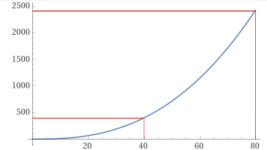
y = 0.02733405x^2.6, x from 0 to 80 - Wolfram|Alpha
Wolfram|Alpha brings expert-level knowledge and capabilities to the broadest possible range of people—spanning all professions and education levels.
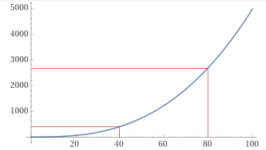
y = 0.01571792x^2.75, x from 0 to 100 - Wolfram|Alpha
Wolfram|Alpha brings expert-level knowledge and capabilities to the broadest possible range of people—spanning all professions and education levels.
He didn't give a specific range, just to keep it "high". Hence why I was suspicious of if it was accurate or not.What flow did the gas fitter recommend?
And wow; thanks for the master-class on heaters! I have some more reading to do.
People who know what they are talking about give real numbers.He didn't give a specific range, just to keep it "high".
Keep it above the minimum by about 10 to 20 GPM.
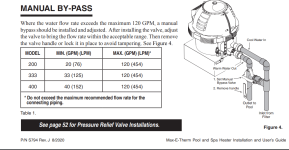
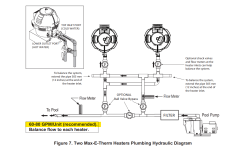
Max-E-Therm High Performance Heater - TradeGrade
Ensure your pool is ready when you are with the Max-E-Therm High-Performance Heater. View models here.
The manual seems to indicate that 60 to 80 is the “Recommended” flow per unit.
Most likely, that is for the 400,000 btu/hr model.
So, that is 1.5 to 2 times the minimum for a 400,000 btu/hr model.
For your model, that would be 30 to 40 GPM.
Most likely, that is for the 400,000 btu/hr model.
So, that is 1.5 to 2 times the minimum for a 400,000 btu/hr model.
For your model, that would be 30 to 40 GPM.
84% efficiency rating.
200,00 btu per hour at 84% efficiency is 168,000 btu/hr.
Temp rise = 168,000/(GPM X 60 X 8.34)
Temp rise = 336/GPM.
Y = temp rise.
X = Flow in GPM.
Y = 336/X
X = 336/Y
If flow = 20 GPM, then the temp rise should be about 16.8 degrees from heater inlet to heater outlet.
If the water temperature going into the heater is 80 degrees, the outlet should be about 96.8 degrees at 20 gpm.
So, you can estimate the flow based on the temperature rise.
For example, if you measure the temp rise at 9.6 degrees, then the flow is about 35 GPM.
You should target a temp rise of about 11.2 degrees (30 GPM) to 8.4 degrees (40 GPM).
As you can see from the below graph, the temp rise at flows beyond 40 GPM does not go down that much.
Once you go below 20 GPM, the temp rise goes up very fast.
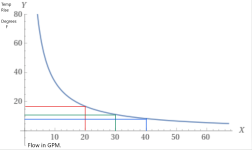
 www.wolframalpha.com
www.wolframalpha.com
200,00 btu per hour at 84% efficiency is 168,000 btu/hr.
Temp rise = 168,000/(GPM X 60 X 8.34)
Temp rise = 336/GPM.
Y = temp rise.
X = Flow in GPM.
Y = 336/X
X = 336/Y
If flow = 20 GPM, then the temp rise should be about 16.8 degrees from heater inlet to heater outlet.
If the water temperature going into the heater is 80 degrees, the outlet should be about 96.8 degrees at 20 gpm.
So, you can estimate the flow based on the temperature rise.
For example, if you measure the temp rise at 9.6 degrees, then the flow is about 35 GPM.
You should target a temp rise of about 11.2 degrees (30 GPM) to 8.4 degrees (40 GPM).
As you can see from the below graph, the temp rise at flows beyond 40 GPM does not go down that much.
Once you go below 20 GPM, the temp rise goes up very fast.

Y = 336/X, y from 5 to 80 - Wolfram|Alpha
Wolfram|Alpha brings expert-level knowledge and capabilities to the broadest possible range of people—spanning all professions and education levels.
Last edited:
Thread Status
Hello , This thread has been inactive for over 60 days. New postings here are unlikely to be seen or responded to by other members. For better visibility, consider Starting A New Thread.

